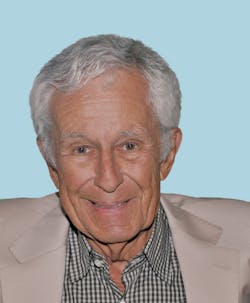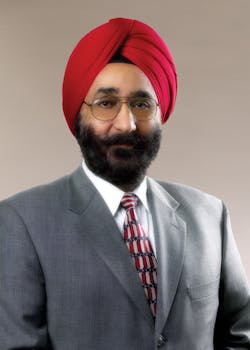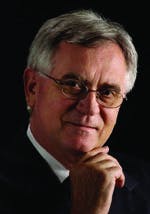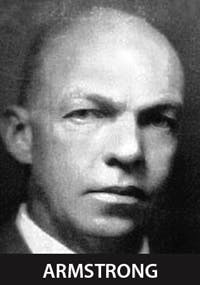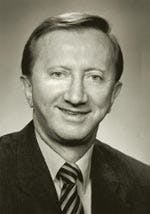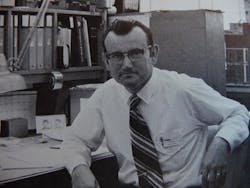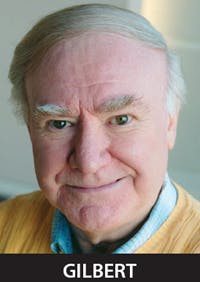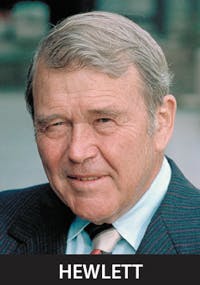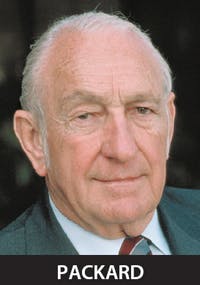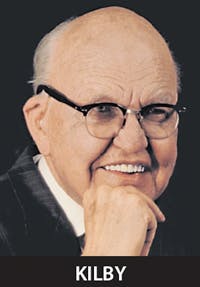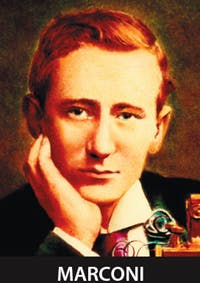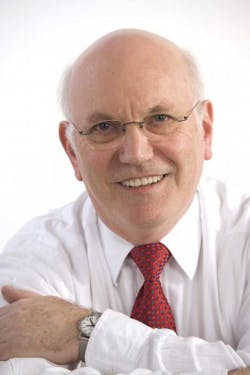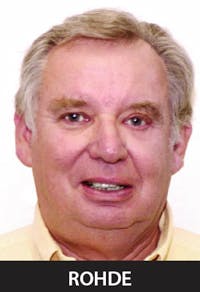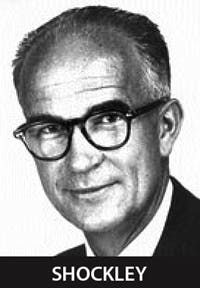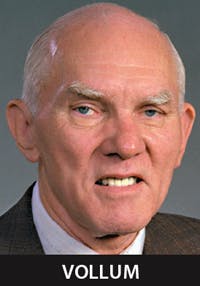This file type includes high resolution graphics and schematics when applicable.
Every August, Microwaves & RF inducts a group of new legends into its honorary Microwave Legends. Inductees are nominated by the editors, as well as the readers. This tradition started in 2007, and below is the entire list. If you would like to nominate a person, place or thing, please contact us.
Borck was never known for mincing words, and many advertising salespeople (including those from this magazine) knew to prepare themselves before meeting with him. Indeed, customers and competitors alike were well aware of his direct manner. But they also realized that underneath the tough exterior was a true gentleman—one who demonstrated clear dedication to his family, as well as a strong love for the RF/microwave industry.
Borck applied his intelligence and passion to everything he did, and he remained involved with RLC up until his passing. He left behind a company with initials that represent the three building-block components of passive components, and one that is certainly in good hands with his successors.
Amarpal P.S. ("Paul") Khanna - Although he is currently an IEEE Fellow, in addition to Vice President of Components and Sub-Assemblies at Phase Matrix, Dr. Paul Khanna is oftenKhanna developed many of the early DRO designs as well as the means to measure these low-noise oscillators. In addition, his time at Avantek produced a number of high-performance yttrium-indium-garnet (YIG) tunable oscillators that would become the low-noise, high-frequency signal sources for many different test instruments. These include the signal generators and spectrum analyzers produced by Hewlett-Packard Co., and later by Agilent Technologies.
In the late 1980s, Khanna created an oscillator technology for DROs and voltage-controlled oscillators (VCOs) in which oscillations are switched on and off by quenching negative resistance with a PIN diode, making possible wideband, spurious-free multiple-oscillator assemblies with fast switching speeds and fast settling times. Khanna earned his Ph.D. in microwave and optical communications from the University of Limoges in France. He holds five US and two French patents.
John Minck - Well known by members of the press during his 37 years at Hewlett-Packard Co., and his subsequent years when it became Agilent Technologies, John Minck was as knowledgeable a Marcom Manager as ever graced his company (or this industry, for that matter). He was well versed on the R&D activities of the test-and-measurement giant’s various divisions. For members of the press, Minck certainly represented a “one-stop shopping” experience, since he was a reliable source for anything new within Hewlett-Packard for those many years.
In fact, proof of his knowledge can be found in the 80-page book, “Inside HP: A Narrative History of Hewlett-Packard from 1939-1990.” It is available as a free download. Minck explains that he started writing the book in the early 1980s as a way for new employees to understand its culture.
Donald Shepherd - The Founder and Chairman of Amplifier Research in Souderton, PA, Shepherd has been a driving force in the RF/microwave industry; he supports major clients in such large markets as the aerospace, automotive, medical, and telecommunications industries. Shepherd literally started AR in his basement, growing it into a global company with an international list of clients.
Microwave Associates - With radar among the wartime technologies that became critical in World War II, a number of engineering firms emerged to serve the new microwave market based on developing radar and other microwave-based systems. One that continues to drive the industry is Microwave Associates, which is now known as M/A-COM Technology Solutions. This firm was founded in 1950 by four ex-Sylvania engineersVessarios Chigas, Richard Walker, Hugh Wainright, and Louis Robertswith $10,000 in capital.
The company introduced a variety of products ranging from magnetrons and microwave components in the 1950s to products targeting the communications and broadcast industries in the 1960s. In fact, it doubled the size of its communications market by introducing new, solid-state, high-performance FM microwave communications equipment for television, telephone, and data transmission. In 1970, the firm replaced vacuum tubes with semiconductors in microwave applications. In the mid-70s, Microwave Associates engineers developed the first high-power PIN diodes.
Lacking support from military customers during the formative years of the company, Marki began to develop mixer technology for commercial microwave applications by continually expanding the high-frequency and wide-bandwidth capability of his mixer lines. In 2003, he introduced the first surface-mount mixer package for suspended substrate mixers to 30 GHz. The next year, Marki introduced the highinput- intercept, "two-tone terminator" (T3) mixer line, which offers unparalleled linearity and bandwidth performance.
Siegfried Knorr - Together with Dr. Betty Chang, Siegfried Knorr founded Colby Instruments, Inc. He is remembered as being one of the most knowledgeable engineers on using the time domain for RF/microwave testing. Among his most notable innovations were programmable microwave and RF delay lines and modules with outstanding accuracy and repeatability.
In 1988, Colby Instruments introduced the precision programmable delay line instruments and phase shifters with resolution to 0.25 ps. The wideband, passive PDL series delay lines, which cover DC to 18 GHz, are free from all noise sources including phase noise and jitter. Using a patented electro-mechanical trombone-line structure, the PDL offers variable, programmable, and repeatable delays with high resolution. Knorr held many patents. He also was a former professor in the Henry Samueli School of Electrical Engineering at the University of California, Los Angeles (UCLA). Throughout his career, he sponsored students from Germany for specialized studies and laboratory experience in high-frequency electronics.
Meppalli Shandas - Known by many as the "father of the microwave power module (MPM)," Shandas has spent more than 35 years designing microwave hardware for electronic-warfare (EW), radar, and communication systems. Shandas was one of the leading contributors to the Tri-Service MPM Program managed by the Naval Research Laboratory (NRL) in the early 1990s, where the MPM was invented. He continued to champion MPM technology and introduced new products throughout his career with Varian (now CPI).
After joining dB Control in 1999 (now part of the Electronic Technologies Group of HEICO Corp.), Shandas was integral to the development of an entire line of MPMs. He is currently dB Control's Vice President of Technology and Business Development. Shandas' contributions have resulted in many innovative, yet practical designs for reliable hardware that can achieve high microwave power over a wide frequency spectrum.
Harry Rutstein - When it came to making a deal, few in this industry could rival Harry Rutstein. An eternal optimist, Rutstein always had his eyes open for opportunities. He started and sold numerous businesses over his lifetime. In the microwave industry, Rutstein is best known for founding Seattlebased Dorado International Corp. in 1979 for the purpose of selling millimeter-wave products made in China to the Western world. In the 1990s, Rutstein began importing ferrite isolators and circulators from Russia.
Rutstein also was passionate about the life of 13th century explorer Marco Polo. He became the first known person to have retraced Marco Polo's footsteps. Rutstein was co-author and photographer for the book, In the Footsteps of Marco Polo: A Twentieth Century Odyssey and later wrote The Marco Polo Odyssey. Rutstein also served as Founder and Executive Director of the Marco Polo Foundation, Inc.
Charles Abronson — Abronson formed EEsof with Bill Childs. In 1983, EEsof introduced Touchstone, which incorporated a unique engine. It would run on both PCs and HP minicomputers, thereby porting microwave computeraided engineering to PCs. Touchstone also allowed the engineer to tune the circuit and see the response move. Eventually, HP bought EEsof. Abronson moved on to become Chairman of CAP Wireless, which specializes in broadband amplifiers and amplifier subsystems for commercial and military applications.
Stephen F. Adam — A force in the industry, this former HP employee has served as the Principal Engineer of the Microwave and Communications Instruments Product Group and 1980 President of the Microwave Theory and Techniques Society. In addition, he has occupied numerous committee member-and chairmanships within the MTT Society and held many other posts in the industry at large. Adam holds several patents. He is the author of many technical articles and the textbook, Microwave Theory and Applications. Adam is president-CEO of Adam Microwave Consulting, Inc.
Avantek — During the 1970s and 1980s, this company set the pace for new developments with broadband YIG oscillators, low-noise amplifiers and devices, and broadband amplifiers. The company's talented mix of device, component, and systems engineers also gave root to a large number of "spinoff" companies throughout the San Francisco Bay area. Those companies include Micro Lambda Wireless, MicroWave Technology, and Celeritek. Based in Santa Clara, CA, Avantek was acquired by Hewlett-Packard Co. Its product lines eventually moved to Agilent Technologies, Penstock, and other companies.
Bell Labs — At one time known as AT&T Bell Laboratories, and now the research & development (R&D) arm of the French-owned Alcatel-Lucent (www.alcatel-lucent.com), this has been one of the world’s top research facilities for microwave, optical, and other electronic technologies. As the Alexander Graham Bell Laboratory, it opened in Washington, DC in 1880 supported largely by grant money from the French government. The telephone’s inventor focused early efforts on recording and processing telephone signals, although he also hoped to increase public knowledge about the deaf and hearing defects.
In 1925, with the consolidation of Western Electric’s research laboratories and part of the engineering department of the American Telephone & Telegraph (AT&T) company, the facility became Bell Telephone Laboratories; ownership of the laboratory was split between Western Electric and AT&T. The laboratory became home for many of the technically famous, including Richard Hamming (Hamming codes for error detection and correction), Harry Nyquist, and William Shockley (the inventor of the transistor). Bell Labs was also a starting point for many key technologies, including charge-coupled devices (CCDs), light-wave communications, and radio astronomy. In 1962, the laboratory launched the first communications satellite, Telstar I, with a 2-W, 4-GHz RCA traveling-wave-tube (TWT) amplifier.
Eli Brookner — Considered Raytheon’s “Ambassador for Radar,” Dr. Eli Brookner is a Principal Engineering Fellow with Raytheon Integrated Defense Systems. As a scientist, writer, and teacher, Brookner is known for his contributions to radars and phased-array radar-system design as well as signal processing in the airborne, intelligence, space, air-traffic control, and defense mission areas. His contributions to Raytheon’s radars cover 43 years.
According to Raytheon, Brookner joined the company in 1962 as a systems engineer. In the 1970s, he collaborated on programs like Cobra Dane and Cobra Judy. He also was heavily involved in the PAVE PAWS proposal development. For the next decade, his focus was on space-based and airborne radars for surveillance. In the 1990s, Brookner’s work included supporting Terminal High-Altitude Air Defense (THAAD). Over the last several years, Brookner has worked on programs like Cobra Dane Upgrade, Cobra Judy Replacement, Upgraded Early Warning Radar, Marine Corps Affordable Ground-Based Radar (AGBR), and multiple proposals including G/ATOR and Long-Range Radar.
Through his career, Brookner has acted as a mentor to dozens of engineers across Raytheon. He also authored four books that have collectively sold more than 26,000 copies and published more than 110 papers and talks. Brookner continues to teach courses on radar, phased arrays, and tracking.
Frank Dawson Bliley — In 1919, Bliley received his first amateur radio license. He went on the air with a spark coil, which was then a 0.5-kW spark transmitter. Two years later, he bought an Audiotron tube and World War I-surplus 50-W transmitter and opened up his radio station on the 200-m band. In 1923—before the amateur frequencies were laid out in "bands"—Bliley (with an experimental license) cooperated with the Naval Research Lab, NKF, and W1XAM, to explore the use of high-frequency energy for various applications. Their goal was to help analyze the propagation properties at various times of the day to frequencies of 30 million cycles per second (Mc or MHz).
In 1925, Bliley attempted transcontinental contact with Frank Jones, W6AJF, on 56 Mc but without success. In 1930, he started making crystals as part of his hobby. This "hobby" quickly grew into the Bliley Piezo-Electric Co. in Carlisle, PA. The company was one of the first commercial crystal-oscillator manufacturers. It also was a supplier to armed forces in WWII. Bliley was known for greatly improving performance through an acid-etch technique, which etched away the final layers of quartz when forming the resonators for crystal oscillators.
Jagadis Chunder Bose — Bose, who was born in 1858 in Mymensingh, India, created the world's first wireless communication link by using millimeter waves for the remote control of a gun. In doing so, he induced electric sparks in a cavity resonator system. In 1895—two years before Marconi's demonstration—Bose transmitted signals through three intervening walls to a room 75 feet away at Calcutta's town hall. In 1898, Bose demonstrated his wireless communication equipment, which was based on the Branly Lodge coherer detector (then dubbed the "Iron mercury iron coherer with a telephone detector").
Meanwhile, Marconi began using a detector in his receiving antenna, which he called a "coherer." This instrument was communicated to him by Luigi Solari, who essentially modified Bose's u-shaped tube into a straight tube. Marconi later admitted that he had actually used an "iron-mercury-iron-coherer with a telephone detector." Among other achievements, Bose is credited with devising the horn antenna and modeling a solid-state detector using Galena. In 1917, Bose founded the Bose Institute.
Harry Boot and John Randall — In 1921, A.W. Hull, who worked for the General Electric Co., published a paper on a discovery that he dubbed the Magnetron. Hull realized that it was possible to reduce an anode current at a certain magnetic-field strength by applying a magnetic field to a diode vacuum tube with cylindrical electronides. About 20 years later, Harry Boot and John Randall— two engineers at the University of Birmingham—decided to build a magnetron that could handle a large amount of power and generate microwave energy in a very efficient manner.
According to the Institution of Engineering and Technology (www.theiet.org), H.A.H. (“Harry”) Boot was born in 1917 in Birmingham. After being educated at King Edward’s School, he went to Birmingham University to study physics. Boot was awarded a BSc in 1938 and a PhD in 1941. After the outbreak of the war, Boot worked in the physics department under M.L.E. Oliphaunt on the development of centimetric radar. At that point, radar was based on long wavelengths and required very bulky equipment to generate and receive these relatively low-frequency signals. As a result, the search area had to be “flooded” to detect any moving objects.
Boot and his colleague, J.A. Randall, were trying to produce wavelengths of 10 cm or less for use in a more focused radar “beam,” which would be more accurate. The two researchers first tried using a klystron as the high-frequency energy source. But they were not able to produce sufficiently short waves. In 1940, they decided to try a magnetron tube. After only a few months, Boot and Randall were able to produce wavelengths of 9.8 cm. The first magnetron radar system was built at TRE Swanage in May of that year. That September, the Bomber Command used it to detect submarines.
In the Battle of the Atlantic, centimetric radar enabled the allies to locate surfaced U-boats in any weather. The magnetron also was critical to the defeat of the German night bombers in 1943 to 1944 as well as in improved accuracy of the allies’ own night bombing. In 1948, Boot was appointed Principal Scientific Officer (PSO) at Services Electronic Research Laboratories, Baldock. There, he undertook research on microwaves, magnetrons, plasma physics, and lasers. He retired in 1977 and died in February 1983.
The life of John Randall is not so widely reported. From Wikipedia, however, the following can be ascertained: Sir John Randall was born in March 1905 in Newton-le-Willows, St. Helens, Lancashire. He was educated at the University of Manchester, where he was awarded a first-class honors degree in physics and a graduate prize in 1925 as well as an MSc in 1926. From 1926 to 1937, Randall was employed on research by the General Electric Company at its Wembley laboratories, where he led the development of luminescent powders for use in discharge lamps. He was then awarded a Royal Society fellowship to the University of Birmingham, where he worked on the electron trap theory of phosphorescence.
When the war began in 1939, he transferred to the group working on centimeter radar. His work with Boot then followed. Later, Randall turned his attention to biophysics. In 1946, he became the Wheatstone Chair of Physics at King’s College London. There, he was Director of the Biophysics Research Unit. During his term as Director, experimental work leading to the discovery of the structure of DNA was made by Rosalind Franklin, Raymond Gosling, and Maurice Wilkins. His own work focused on the structure of collagen.
In 1970, Randall retired to Edinburgh University, where he formed a group that applied a range of new biophysical methods to study various biological problems. He died in June 1984.
Botka has earned a total of 15 patents, including for a slotless microwave connector. He is also credited with extending the initial 1-GHz frequency limit of the Type N connector invented by Paul Neill at Bell Labs to its present-day limit of around 18 GHz. He joined HP/Agilent in 1966 and is currently Agilent R&D Project Manager for Microwave Components and Standards. In this role, he continues to contribute to precision components for the firm’s lines of test sets and microwave instruments.
Pafnuty Chebyshev — Chebyshev wrote numerous papers. His namesake polynomials first appeared in "Thèorie des mècanismes connus sous le nom de parallèlogrammes" in 1854. Chebyshev later developed a general theory of orthogonal polynomials. That work had its roots in the theory of least squares approximation and probability. Chebyshev is credited with discovering the discrete analog of Jacobi polynomials.
Seymore Cohn — After WWII, there was a resurgence in interest in the small aperture or obstacle theory. Cohn used precise electrolytic tank measurements to attain the electrostatic polarization possibilities for aperture shapes that did not fit into any theory. He also did work on the ridge waveguide. Cohn made his largest mark on the industry by coming up with a formula that made it easy to calculate characteristic impedance over all dimensional parameters. By taking into account the fringing fields at the sides, he was able to approximate a wide strip. A narrow strip was approximated by selecting an equivalent circular rod.
The Defense Advanced Research Projects Agency— DARPA was established in 1958 in response to the Soviet launching of Sputnik. Since that time, the agency's mission has been to ensure that the US maintains a lead in applying stateofthe-art technology for military capabilities while preventing any technological surprises from its adversaries. Much DARPA-supported work of the past spawned the successful consumer technologies of today.
Lester Eastman — Many semiconductor students and designers attribute their knowledge to this Cornell University professor. He has been doing research on compound semiconductor materials, high-speed devices, and circuits since 1965. Eastman also has won numerous awards and held many distinguished posts in both engineering education and the microwave industry.
Harald T. Friis — During a stint at Western Electric in 1922, Friis succeeded in applying a superheterodyne circuit to radio. Although he held multiple patents that reflected years of research, Friis is best known for creating the noise-figure theory while working for Bell Labs in 1942. Thanks to this theory, engineers can calculate the signal-to-noise ratio at the output of a complex receiver chain.
Dr. M. Fukuta— In 1963, Fukuta joined Kobe Industries Co., which later merged with Fujitsu Ltd. He began working in the field of semiconductor devices including Si RF power transistors, Si ICs, and Si MOSFETs. In 1967, Fukuta invented "the mesh emitter transistor." At ISSCC '73, he presented the first paper on power GaAs FETs titled, "Mesh Source Type Microwave Power FET." In 1992, Fukuta became President of the Compound Semiconductor Group at Fujitsu and later helped to form Eudyna Devices.
John B. Gunn— In 1963, Gunn successfully demonstrated microwave oscillations in gallium-arsenide and indium-phosphide diodes while working at IBM Corp. His discovery became known as "The Gunn Effect." This term refers to the negative resistance that is produced when an electric field in a material reaches a threshold level, thereby decreasing the electrons' mobility as the electric field grows. The effect is used in a solidstate device, dubbed the Gunn diode, to produce microwaves.
Robert C. Hansen — This antenna guru was probably the first person to simulate antennas on a mainframe computer. His numerous papers and books cover a range of topics like low-noise antennas, near-field power densities, reduced RCS measurements, minimum spot size of focused apertures, and the inductive loading of short monopoles. Hansen also has written over 100 papers on electromagnetics.
William Webster Hansen — This physicist is regarded by some as the founder of microwave technology. As a Stanford University physics undergraduate student, he became close friends with Russell Varian. The klystron actually was inspired by the two friends' interest in X-rays. Hansen and the Varian brothers partnered on many ideas, inventions, and projects in the 1920s-1940s.
In 1937, Hansen began trying to solve the problem of detecting approaching aircraft. Together with the Varian brothers, he developed the klystron. In 1941, Hansen and his research group moved to the Sperry Gyroscope Co. in Garden City, NY. There, Hansen contributed to developments in Doppler radar, aircraft blindlanding systems, electron acceleration, and nuclear magnetic resonance.
Joseph Henry — This scientist discovered the phenomenon of self-inductance, which is why the "henry" is named for him. He was the first to wind insulated wires around an iron core in order to obtain powerful electromagnets. When the circuit was broken, Henry noted that a large spark was generated. He then deduced self-inductance—the inertial characteristic of an electric circuit. Henry found that a circuit's configuration greatly impacts self-inductance.
Heinrich Rudolph Hertz — Hertz confirmed James Clerk Maxwell's theories about the existence of electromagnetic (EM) radiation. In 1886, this German physicist caused a spark discharge between a spark gap's poles, which were oscillating at a frequency determined by the values of the capacitor and the induction coil. For the radio-wave transmitter, Hertz used a high-voltage induction coil, condenser, and spark gap. To detect radiation in order to prove that it was being emitted, Hertz used 1-mm-thick copper wire. He bent that wire into a circle and put a small brass sphere on one end. The other end of the wire was pointed.
With the screw mechanism that Hertz added, that point could be moved very close to the sphere in a controlled fashion. If there were an oscillating charge in the receiver, sparks would appear across the gap between the point and the sphere. Hertz later established that light is a form of electromagnetic radiation that obeys Maxwell's equations. The unit of frequency—cycles per second—is named the "hertz" in his honor.
Bill Hewlett and Dave Packard — In 1938, these friends and Stanford University alumnae set up their first workspace in a garage in Palo Alto, CA. Their initial capital was reportedly $538. They created the first Hewlett-Packard product—a resistance-capacitance audio oscillator.
The HP Model 200A was used to test sound equipment. Sixty years later, they had a $25-billion company that was central to propelling technology forward (and would spin off their test and measurement business as a separate public company, Agilent Technologies).
Aside from technology innovation, these famous founders are known for the work atmosphere that they created, dubbed "The HP Way."
HP 8510 — In the early years of microwave engineering, engineers would measure the input and output voltages of their circuits with a voltmeter and calculate the insertion loss and return loss based on what they could derive from Maxwell's equations. Hewlett-Packard Co. then developed the vector voltmeter, which allowed voltage amplitude and phase to be measured. After some more developments, it came out with the HP 8510 automatic network vector analyzer, which combined HP measurement capability with the power of a microprocessor. Engineers could then automate complex measurements on a microwave DUT and apply error correction.
HP Microwave Semiconductor— HP Associates, an affiliate of Hewlett-Packard Co., supplied specialized silicon, germanium, and gallium-arsenide diodes for HP test systems. In 1964, it was renamed HP Microwave Semiconductor Operation (MSO) and began marketing components to customers outside of HP. In 1978, HP MSO introduced the first fiber-optic transmitters and receivers for data communications. The next year, it announced the first integrated microprocessor development system to combine all of the tools that were needed by hardware and software engineers. In 2005, it became Avago Technologies.
Cyril Hilsum — Much of history is muddled with multiple claims to the same invention and misappropriated credit. In this vein, many feel that John B. Gunn should not be solely credited for discovering the transferred electron effect. Most of the legwork that made his “discovery” possible is widely credited to semiconductorauthority and Professor Cyril Hilsum.
Born in 1925, Hilsum obtained a BSc and PhD in physics from University College, London. Hilsum worked at the Admiralty Research Laboratory from 1947 to 1950, the Services Electronics Research Laboratory (SERL) from 1950 to 1964, and the Royal Radar Establishment until 1983. After devoting 40 years to the UK Ministry of Defense, Hilsum served as Director of Research at General Electric Co. Hirst Research Centre from 1983 to 1992. During his tenure at the Ministry of Defense, Hilsum was instrumental in the development of gallium arsenide (GaAs) as a semiconductor material. Among the applications of GaAs were transistors and lasers.
Hilsum also was involved in the use of indium antimonide as an infrared detector material. In addition, he did early work on liquid-crystal displays (LCDs). He was named a Foreign Associate of the National Academy of Engineering for introducing III-V semiconductors into electronic technology. His written works include the 1961 volume titled, Semiconducting III-V Compounds (Monographs on Semiconductors).
Harold Isaacson — World War II pilot and hero Harold Isaacson enjoyed developing new products and put that love into the creation of one of the industry's longest-running and least-known success stories—ARRA (Bayshore, NY).Isaacson developed the firm's lines of passive components—including its continuously variable attenuators—that are still widely used in military systems and commercial test equipment.
William Jarvis — Jarvis founded Wiltron Co., a test and measurement leader that was acquired by Anritsu Corp. in 1990. In the 1980s, Jarvis drove Wiltron's engineers to develop an answer to the market-dominant HP 8510 vector network analyzer introduced by Hewlett-Packard Co. The result, with a company the fraction the size of HP at that time, was Wiltron's first network analyzer— the 360. Anritsu continues to build on Wiltron's products today.
Harvey Kaylie — In 1969, this electrical engineer saw a chance to strike out on his own, thanks to the development of the double-balanced mixer. He founded Mini-Circuits in Brooklyn, NY with a simple formula for success: The company would manufacture quality products, sell them at a very competitive price, and provide fast delivery. Since then, Mini-Circuits has grown into a leading manufacturer of double balanced mixers while offering a diverse selection of RF, IF, and microwave products.
Aksel Kiiss — One of the seven founding members of MITEQ (see "Charting The Course For 45 Years of Microwaves"), Kiiss became the company's second (and most influential) president in 1971— three years after helping to start the company. He fostered an entrepreneurial spirit (inspired by his earlier years at AIL) among his engineers. Anyone at the company who had an idea for a new business was given funding and a chance to succeed or fail. That formula resulted in the extensive amplifier, oscillator, synthesizer, and subsystem product lines that make up the company today.
Although he passed away in 1999, Kiiss' love and respect for his co-workers is kept alive at MITEQ, which is regularly named as one of the most desirable places to work in Long Island, NY.
Julius Lange — While working at Texas Instruments in 1969, Lange created the microstrip interdigitated quadrature coupler. Previously, tight coupling in directional couplers was attained for microwave ICs through broadside coupling, re-entrant sections, tandem sections, or branch-line couplers. In contrast, interdigitated microstrip couplers comprise three or more parallel striplines with alternate lines tied together. They utilize one groundplane, one dielectric, and a layer of metallization.
Magnetron — A.W. Hull, who worked for the General Electric Co., published a paper on his discovery, which he dubbed the Magnetron, in 1921. He realized that it was possible to reduce an anode current at a certain magneticfield strength by applying a magnetic field to a diode vacuum tube with cylindrical electronides. About 20 years later, Harry Boot and John Randall—two engineers at the University of Birmingham—decided to build a Magnetron that could handle a large amount of power and generate microwaves in a very efficient manner.
In addition, Kinjiro Okabe, associate professor at Tohoku Imperial University, discovered that the Magnetron creates small oscillations of shorter wavelengths under certain conditions. Using their knowledge of Magnetrons, British and American scientists were able to perfect radar. The result changed the face of history, starting with the winning of the Battle of Britain.
Marconi transmitted the first wireless signals across the Atlantic between Poldhu, Cornwall, and St. John's, Newfoundland in December of 1901 (a total of 2100 miles). He also patented a magnetic detector, which long served as a standard wireless receiver. His work in short waves is credited with the creation of the beam system for long-distance communication.
Mario A. Maury Sr. — In October of 1957, connector inventor Mario Maury founded Maury and Associates in Montclair, CA. With help from his sons, Mario A. Maury Jr. and Marc A. Maury, he made the company a leader in the microwave test and calibration industry. Maury and Associates also created a comprehensive line of precision instruments, coaxial and waveguide components, and support products. Now known as Maury Microwave Corp., the company credits its success to the values upon which it was founded: teamwork, pride in the company, and dedication to customer service and quality.
James Clerk Maxwell — The "father of modern physics," as he is often called, discovered the theory of electromagnetism. His equations, which were proven correct by Heinrich Hertz, are at the root of computational electromagnetics. Maxwell put forth the idea that energies reside in fields as well as bodies. His work has impacted and spawned the fields of communications, thermodynamics, engineering, mathematics,and more. Surprisingly, the genius of his electromagnetic theory was not realized until after his death.
MIT Lincoln Lab — With roots in the Massachusetts Institute of Technology (MIT) Radiation Laboratory—which was in turn formed out ofThat first air defense system, known as the Semi-Automatic Ground Environment (SAGE), drove the development of numerous technologies, including digital computers, magnetic memory, and graphical user interfaces (GUIs). The laboratory was also an innovator in early-warning radar systems for use over air, over water, and even over the Arctic. It now serves as a technology pioneer for many advanced technologies in support of Homeland Security; cyber security; air and missile defense systems; intelligence, surveillance, and reconnaissance (ISR) systems; and communications security technologies.
MIT Radiation Laboratory — In September of 1940, England dispatched the secret Tizard Mission—armed with a 10-cm cavity magnetron—to Washington, D.C. to get help making microwave radar work. MIT was chosen as the site of the resulting independent laboratory. The "Rad Lab" designed almost half of the radar deployed in World War II. The lab, which was operational until 1945, employed 3900 people. Their contributions to theory and technology, operational radar, systems engineering, navigation, and control equipment are still impacting current technologies.
Bill Oldfield — Along with Mario Maury and HP/Agilent's Julius Botka, Oldfield is one of the microwave industry's leading "machinists"—a term that encompasses the brilliant capability to envision and fabricate new microwave structures like connectors. With the creation of the K connection at Wiltron (eventually to be acquired by Anritsu) in the 1980s, Oldfield helped to push coaxial connectors past the limitations of the SMA connector. He followed this breakthrough with the design and development of the V connector, reliably enabling coaxial connectors to work through millimeter-wave frequencies. Oldfield is responsible for much of the passive and interconnect technology that enables Anritsu's microwave test equipment.
Arthur Oliner — Dr. Oliner is one of the three founders of Merrimac Industries, Inc. Over roughly 60 years in the industry, he has performed many firsts. For example, Oliner provided radiatingslot analysis in a rectangular waveguide that included both reactive and resistive effects. Engineers are still using his theory of Wood's anomalies on optical grating, which focuses on a guided-wave approach. In addition, Oliner's analysis of phased-array antennas was the first to accurately account for mutual coupling effects.
Allan Podell — Long at the forefront of IC technology, Podell envisioned commercial applications for GaAs MMIC devices during the 1980s, when most GaAs IC research was heavily funded by DARPA. Along with Doug Lockie (who would later found Endwave Corp.), he founded Pacific Monolithics in Sunnyvale, CA. The company was an innovative developer of GaAs IC amplifiers, oscillators, mixers, and receiver front ends.
Pollard’s professional focus was on microwave solid-state devices and circuits. He was appointed Lecturer in the Department of Electrical and Electronic Engineering at Leeds in 1974 and awarded his Ph.D. in 1980, with a promotion to Senior Lecturer in 1985. At the same time, he served as a consultant to numerous RF/microwave companies, including HP/Agilent. He contributed to 10 books and about 150 articles, and lays claim to three patents. He also supervised over 50 Ph.D. candidates. He was elected a Fellow of the US Institute of Electrical and Electronic Engineers (IEEE) in 1997, and awarded the Measurement Prize by the UK Institution of Electrical Engineers (IEE) in 1999 and the IEEE Third Millennium Medal in 2000. In 2005, he was elected a Fellow of the Royal Academy of Engineering. He was also a Fellow of the Institution of Engineering and Technology.
Ray Pengelly— Pengelly and James Turner are co-inventors of the monolithic microwave integrated circuit (MMIC). While they were working at Plessey in 1975, the two men published “Monolithic Broadband GaAs F.E.T. Amplifiers.” They managed to coax 5 dB of gain out of their small, single-stage amplifier at the X-band. To do so, they leveraged 1-µm optically written gates. According to the “History of MMICs” entry at Microwaves101.com, they used computer optimization to design their lumpedelement matching structures. These structures included capacitors and inductors but no direct-current (DC) blocking on the input/output.
Because backside processing had not yet been worked out, the FET’s source was grounded externally. Pengelly gained his BSc and MSc degrees from Southampton University, England in 1969 and 1973, respectively. He began working at the Plessey Company in 1969 and managed the GaAs MMIC department at Plessey Research, Caswell from 1978 to 1986. During this time—and after several years of development—the department produced one of the world’s first phased-array radar transmit/receive modules to be put into a demonstration system.
Beginning in 1986, Pengelly served as Executive Director of Design for Analog and Microwave GaAs MMICs at Tachonics Corp. in Princeton, NJ. After a stint at Compact Software, Pengelly was employed at Raytheon Commercial Electronics (Andover, MA) in a number of positions including MMIC Design and Product Development Manager and Director of Advanced Products and New Techniques. Under these capacities, he managed a growing team to develop new products for emerging markets including power amplifiers for wireless-local-loop applications using pHEMT technology, SiGe mixed-signal products, flip-chip and chip-scale packaging, and new subsystem techniques such as I/Q pre-distortion.
Since August 1999, Pengelly has been employed by Cree, Inc. in Durham, NC. Pengelly has written more than 100 technical papers and four technical books. He holds 12 patents.
THOMAS RUSSELL — Russell, a brilliant microwave designer specializing in directional couplers, founded Krytar in the early 1980s as a way to pursue his love of engineering. His management style was based on the trust and respect of his employees and in placing value on their opinions. Russell developed one of the first proprietary computer-aidedengineering (CAE) tools for the creation of microwave couplers, which he used for the design and development of many of the company's standard product lines.
David Sarnoff — This media giant, who founded both RCA and NBC, foresaw the eventuality of static-free radio, color television, VCRs, and more. He understood that by linking hundreds of stations and offering the right programming, television would catch on in America. Sarnoff was known to be a ruthless businessman when it came to patents and other ways of pushing technology forward. To protect its own interests, RCA reportedly did not help Edwin Armstrong in his legal suit against de Forest. Yet this original media giant can be credited with sending microwave engineering into an extraordinarily higher level of production and development.
Walter Schottky — In 1914, this professor and researcher uncovered what became known as the Schottky Effect — the way that an electric field reduces electron work function. He also is credited with developing the space-chargegrid and screen-grid tubes. Schottky created the superheterodyne detection principle, which focuses on shot noise and electron thermodynamics. Among his other namesake discoveries is the Schottky Barrier, which was named for his efforts to verify the barrier layer in the metal-semiconductor contact. The gate contact of all MESFETs has its lineage in his work.
Shortly thereafter, however, Shockley greatly improved their design. His version comprised three semiconductor layers that were stacked on top of each other. Current flowed through the semiconductor material. Voltage on the center layer could be adjusted to turn the amplifier on and off. They called it a transistor, thereby combining the words "transfer" and "resistor." In 1956, the three men received the Nobel Prize in physics for their work, which led to the development of the first silicon chip.
Charles G. Smith — Starting in 1922 with the design for a refrigerator, Charles G. Smith convinced his friend Laurence K. Marshall, Marshall’s friend Vannevar Bush, and various other investors to build a company around the refrigerator design. They collected enough money to start The American Appliance Company but, after three years, failed to produce a practical refrigerator. Hoping to salvage something from the venture, Marshall and Bush convinced Smith to convert the pump technology from the refrigerator into the design of vacuum tubes. In 1925, Smith had developed what he called a “gaseous rectifier”—a type of valve or vacuum tube for use in radios—allowing radios to work on AC power rather than on batteries. The tube was marketed as the Raytheon rectifier and, in 1927, the company was renamed Raytheon after its million-dollar product.
Microwave Legend Percy Spencer joined the company in 1925 and quickly contributed to the development of many different types of valves or microwave tubes, many of which would be used for the company’s growing radar systems business. The concept of radar (radio detection and ranging) began in the early 1900s, but the availability of the high-power electron devices—such as Raytheon’s magnetrons—made the realization of working radar systems possible, and a key ingredient in the coming World War II.
Philip Smith — His namesake Smith Chart has been used for years to develop impedance-matching networks and to solve transmission-line and waveguide problems. The well-known chart is composed of constant-resistance circles, constant-reactance circles, radius lines, and circles of constant standing-wave ratio. It shows every complex impedance in one easily understood circle.
George Clark Southworth — Southworth is considered most responsible for the development of waveguides. Born in 1890, he studied very-short-wavelength radio waves at Yale University and completed a Ph.D. there in 1923. Southworth then went to work for AT&T, where he specialized in the transmission of very-high-frequency (VHF) EM waves. In 1931, he began to study wave propagation in dielectric rods. Southworth had observed wave propagation in a water-filled copper pipe by early 1932.
The next year, he transmitted waves through air-filled copper pipes that were up to 20 feet long using high-frequency vacuum tubes. According to Southworth, the first message sent through a waveguide was, "Send money." After the waveguide demonstration, he received authorization to construct a 5-in.-diameter guide with a length of 875 ft. for further tests. In 1934, Southworth and his waveguide project were moved to the Bell Telephone Laboratories. Southworth's waveguides were key to the radar systems used during World War II.
Nikola Tesla — Tesla actually held the first radio patent, in which he described a transmitter and receiver with tuned circuits. His initial demonstration of an apparatus for radio transmission and reception took place in 1893 during a lecture in St. Louis before the National Electric Light Association. This demonstration took place 11 years before Marconi's first wireless patent.
Tesla's leadership in radio was recognized in June 1944, when the US Supreme Court posthumously ruled in Tesla's favor in "Tesla v. Marconi," Case 369. Among this inventor's many other innovations were polyphase electric power, brushless synchronous and induction motors, the Tesla bladeless turbine and pump, wireless electric-power-transmission concepts, and wireless remote control. Tesla was granted 221 patents worldwide including 113 US patents.
Russell and Sigurd Varian — At Stanford University's Physics Department, the Varian brothers and William Hansen built numerous models of a two-cavity oscillator—the first microwave tube. The first klystron device was lit on August 19, 1937. When it reached a high enough temperature, the cathode's special coating gave off electrons. Through the first cavity of the klystron tube passed negatively charged electrons, which were attracted by a positively charged anode. The microwaves in the cavity interacted with the electrons and then traveled through a drift tube. The klystron led to the airborne radar used in modern aircraft. It also is credited with enabling satellite communications, missile guidance, radiation oncology, and more.
Dean Watkins and Dick Johnson — In 1957, they founded the Watkins-Johnson Co. For 40 years, the company designed manufactured microwave components, subsystems, and systems for the defense marketplace. Watkins-Johnson was especially well-known for its vacuum tubes and receiver systems, which are credited with inspiring many modern communications devices. Now known as WJ Communications, it focuses on semiconductors and RFID.
Sir Robert A. Watson-Watt and A.F. Wilkins — In 1932, Watson-Watt came up with the idea of Radio Direction Finding. He then co-wrote a paper with A.F. Wilkins that detailed this method of radio detection and ranging, dubbing it radar. To obtain a grant, the two men performed their first demonstration, which took place in the UK. By using transmissions from the BBC short-wave station at Daventry, they measured the power reflected from a Heyford bomber flying up and down at different ranges. Detection was achieved at up to eight miles.
Bob Wenzel — Many current and future microwave engineers are indebted to Wenzel for their know-how. He offers instruction on topics like microwave filters, couplers, and matching networks. Wenzel also delves into common types of filter responses and calculations, filter realization, various methods of filter design, and more.
Ernest Wilkinson — In the 1960 IRE Transactions on Microwave Theory and Techniques, Wilkinson presented a paper titled, "An N-way Hybrid Power Divider." To demonstrate his nowfamous power divider, he used a circular, eight-way coaxial divider with a center frequency of roughly 500 MHz. Essentially, the Wilkinson divider splits one input signal into two equal-phase output signals. Alternatively, it may merge two signals that are of equal phase into one signal moving in the opposite direction.
This file type includes high resolution graphics and schematics when applicable.
About the Author

Nancy Friedrich
RF Product Marketing Manager for Aerospace Defense, Keysight Technologies
Nancy Friedrich is RF Product Marketing Manager for Aerospace Defense at Keysight Technologies. Nancy Friedrich started a career in engineering media about two decades ago with a stint editing copy and writing news for Electronic Design. A few years later, she began writing full time as technology editor at Wireless Systems Design. In 2005, Nancy was named editor-in-chief of Microwaves & RF, a position she held (along with other positions as group content head) until 2018. Nancy then moved to a position at UBM, where she was editor-in-chief of Design News and content director for tradeshows including DesignCon, ESC, and the Smart Manufacturing shows.


